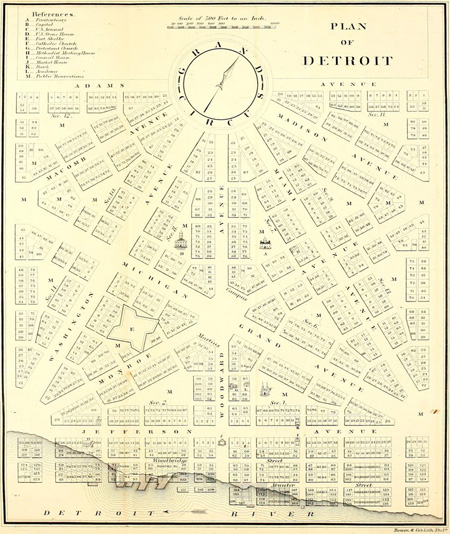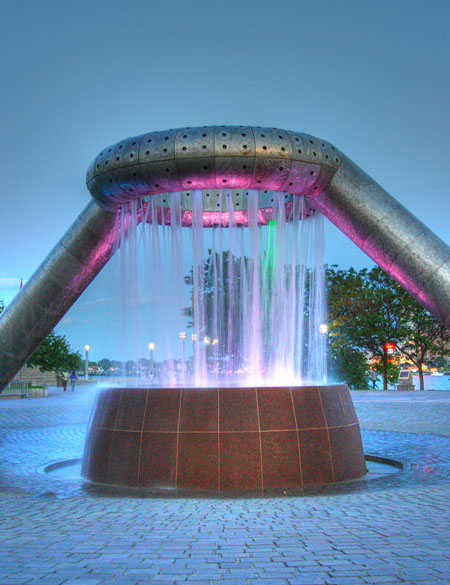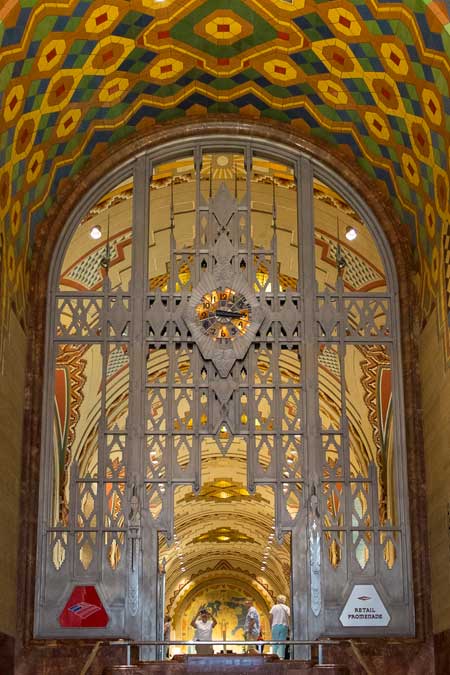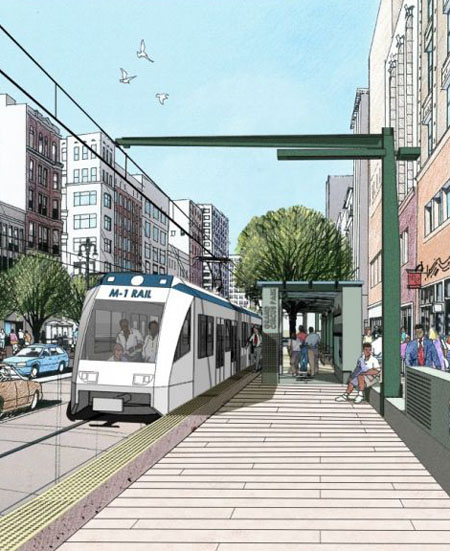The Resurgence of Downtown Detroit
John Varvatos boutique, downtown Detroit / John Varvatos
"The opportunities Detroit has today are a logical evolution from its past mistakes and disinvestment. To an extent, change wouldn't be possible without that," explained Kent Anderson, ASLA, principal at Hamilton Anderson Associates in a tour of downtown Detroit during the Congress for New Urbanism (CNU). He added that Detroit native Dan Gilbert, the founder and owner of Quicken Loans, who has bought up nearly 80 buildings downtown over the past decade, is largely responsible for the resurgence today. "Gilbert recognized the time was right for setting a new direction."
Anderson raced us through a walking tour of downtown, explaining the history of the area and how the city got to where it is today. The city was founded by the French in 1701 as a fur trading outpost. In the early 1700s, the British took over control. In 1760, they were defeated by the American revolutionaries, but they largely maintained control over the growing city until the end of the 18th century, when the Americans retook it. In 1805, a fire started by a baker destroyed much of the city's core. August Woodward, who was "trained in classics at Columbia University," stepped in to create a new urban plan — a hexagonal plan with a set of radials, modeled on Pierre Charles L'Enfant's plan for Washington, D.C.
Woodward Plan / Map of the Week
Many called Woodward a "charlatan and a fool; he was not the most popular guy." But somehow much of his unique plan was implemented.
Woodward plan aerial, 1920 / State of Fred
Woodward's plan established small parks as nodes. Only a few of these remain today, Anderson explained. In fact, so much was lost to misguided urban renewal efforts, which ran from the 1950s to 1970s. "Urban renewal also destroyed a lot of cultural heritage downtown," wrecking particular havoc on important African American arts and music communities.
And of the original immigrant communities — Corktown for the Irish, Chinatown, and Greektown — only the Greeks have survived. In the 80s and 90s, their neighborhood offered the "only nightlife in Detroit." To lure tourists, they created a "trappers alley, with trinket shops," which failed. They then went in for casinos, which now frame the narrow streets bustling with restaurants and baklava shops.
As we walked, Anderson explained in rapid-fire the fate of many of the towering buildings built many decades ago, during the city's golden age. The former Wayne County Building, built in the 1880s, is now viewed as a "dinosaur" by the local development community and has sit empty for years.
Old Wayne County Building / Crain's Business
In the late 1950s, a cornice fell off a building downtown, killing a pedestrian. The city demanded building owners secure the cornices on their buildings, but to lower costs many just removed them, as seen in this charismatic but incomplete flatiron building. "If you see a cornice restored today on an older building, it's most likely fiber composite."
Detroit's Flatiron building / Flickr
As we walk down to the waterfront, we see a prime example of a "fortress building," the Renaissance Center, which was home to Ford's headquarters, and now hosts GM. The building, towering and unfriendly, was another urban renewal effort, built in the 1970s. As race relations hit new lows after the riots and white flight, "there was a fear of cities," Anderson explained, hence it's fortress-like nature.
Renaissance Center, Detroit / Wikipedia
Henry Ford the 2nd decided to bring Ford's workers back to the urban core in an effort to "stop the decline of downtown, but the building had no connection to anything. Employees would drive in, park in the building, take a tube to their desk, take another tube to the cafeteria, and, then, at the end of the day, drive home." Anderson called it a "failed" effort, despite a renovation by architects with SOM from 1995-2000, which introduced a somewhat inviting entrance and interior circulation system, and fake palm trees. "It just looks like an assembly line in here; people seem afraid to move the tables."
Renaissance Center interior / SOM
As we exit from the rear of the Renaissance Center, we come out at the Detroit Riverwalk, which was created in 2000 to connect the waterfront to Belle Isle, an island park. "It's highly used, very successful." We walk through a plaza more-recently created by Hargreaves Associates and then make our way to the vast Philip A. Hart plaza, another urban renewal effort, created by SmithGroupJJR with a fountain and sculpture created by the great Modern artist Isamu Noguchi, and another "failed, lonely space," unless there is some massive event.
Dodge foundation in Philip A. Hart Plaza, Detroit / Wikipedia
Decades of disinvestment in downtown Detroit means that many of the city's Art Deco gems escaped the wrecking ball, and now stand as beacons of resurgence, as they attract new shops and cafes in their ground floors and companies in their towers. Entering the Guardian building, the tour group gushed over the intricate Native American motifs carved set in the ceilings. But not everyone was awed: a man who works there saw our tour group and said: "I don't know why anyone come to see this building; it's so old and outdated."
Guardian building, Detroit / Wikipedia
Then on to one of the finest examples of how landscape architecture can drive a downtown's resurgence anywhere: Campus Martius Park. The space, which occupied a central node in Woodward's plan, was a central meeting space for over a century, but over 1980s and 90s, it was slowly eviscerated, becoming a glorified traffic circle with a statue. In the early 00s, the Detroit 300, a group representing old Detroit money, invested in creating a new park. The result, which opened in 2004 and was designed by Rundell Ernstberger Associates from Indianapolis, is a dynamic 1.2-acre space, often called "Detroit's living room," packed with performance stages, moveable chairs, lush greenery, multiple restaurants, and an urban beach. In the winter, there's also a skating rink that draws tens of thousands.
Campus Martius Park / Campus Martius Park
Campus Martius Park / Show Me Detroit Tours
For Anderson, Campus Martius Park "may have provided a glimpse of what was possible," and served "as the stimulus for getting things started, just before Gilbert committed to downtown."
Walking up Woodward Avenue seeing every storefront occupied by a hip restaurant or shop, it's clear how far Detroit has come in the past few years, due to a coordinated multi-sector development effort, largely led by the private sector. "What's important to understand is it wasn't one building or so-called impact project this time around, unlike past efforts to revitalize the downtown. This time, it is a strategic idea involving many buildings with an intent to connect them with a network of public and semi-public spaces — where everything works together to reveal the unique character of downtown Detroit and transform it."
To further accelerate the process of turning Woodward Avenue into a shopping hub that can draw in people from the outskirts of this vast city and the suburbs, a new streetcar, financed by the private sector, is expected to start running later this year. Anderson said Gilbert and other local developers, who are turning old vacant office buildings into apartment buildings that will bring upwards of 5,000 units onto the market, are confident "the entire district will soon be filled up."
Rendering of M-1 Streetcar line, Woodward Avenue / Next City
Indeed, a taxi driver I spoke to on the way to the airport said he had move out of downtown because his rent doubled in the past year. He believes people need to make at least $55,000 a year to live downtown now. But he wasn't complaining — "Detroit has been waiting a long time for this to happen; I was just shocked they raised the rent so fast."
Anderson believes after years of failed revitalization efforts, this is Detroit's chance. "We'll see how things go over the next 5 years, but I believe the city has gotten it right this time. Everyone is on the same page for the first time."












